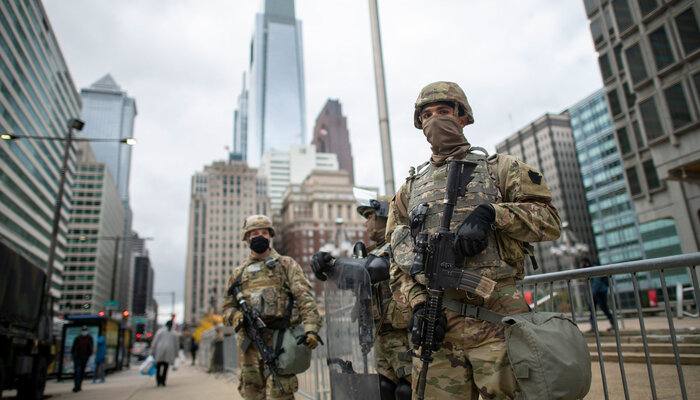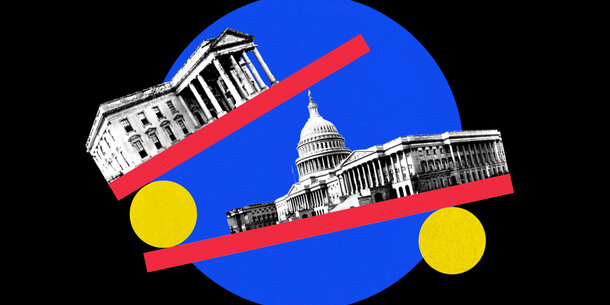- La Ley de Insurrección debería utilizarse únicamente durante una crisis que, de veras, supera la capacidad de control de las autoridades civiles.
- El Congreso debe enmendar la Ley de Insurrección y definir con más claridad y precisión en qué situaciones se puede invocar.
Suscríbete aquí al boletín informativo del Brennan Center en español
Esta ley promulgada en 1792 concede al presidente el poder de desplegar fuerzas militares federales dentro del país y usarlas contra la población estadounidense en determinadas condiciones. Si bien son raras las circunstancias en las que pueda ser necesario hacer uso de esta facultad, esta ley, que no ha sido actualizada de manera significativa en más de 150 años, es peligrosamente amplia y propensa al abuso.
El presidente Trump ha amenazado con invocar la Ley de Insurrección para desplegar tropas militares en servicio activo en ciudades estadounidenses, si la justicia le impide federalizar y desplegar fuerzas de la Guardia Nacional según otra ley.
Más sobre el despliegue interno de fuerzas militares >>
¿Qué es la Ley de Insurrección?
La Ley de Insurrección autoriza al presidente a desplegar fuerzas militares dentro de los Estados Unidos para reprimir una rebelión o violencia interna, o para hacer cumplir la ley en determinadas situaciones.
Esta ley implementa la facultad del Congreso concedida por la Constitución de “estipular el llamamiento de la milicia para ejecutar las leyes de la Unión, reprimir insurrecciones y repeler invasiones”. Es la principal excepción de la Ley Posse Comitatus, que, en términos generales, prohíbe a las fuerzas militares participar en actividades civiles de orden público.
Si bien se la conoce como la “Ley de Insurrección de 1807”, en realidad es una combinación de varias leyes promulgadas por el Congreso entre 1792 y 1871. Hoy en día, esas disposiciones están recogidas en las Secciones 251 a 255 del Título 10 del Código de los Estados Unidos.
¿Qué permite hacer al presidente y a las fuerzas militares la invocación de la Ley de Insurrección?
En circunstancias normales, la Ley Posse Comitatus prohíbe a las fuerzas militares de los EE. UU. —incluidas las fuerzas armadas federales y las tropas de la Guardia Nacional que han sido llamadas a cumplir un servicio federal— que participen en las funciones civiles de orden público. Esta prohibición refleja una tradición estadounidense que considera la interferencia militar en el gobierno civil como una acción inherentemente peligrosa para la libertad.
La invocación de la Ley de Insurrección suspende temporalmente la regla de Posse Comitatus y le permite al presidente desplegar las fuerzas militares para asistir a las autoridades civiles en la ordenación pública. Con este fin, los soldados pueden desde hacer cumplir una orden judicial federal hasta reprimir una sublevación contra el gobierno. Claro que no todos los usos de las fuerzas militares dentro del país implican actividades de orden público.
Otras leyes, como la Ley Stafford, permiten el uso de las fuerzas militares para responder a los desastres naturales, las crisis de salud pública y otros acontecimientos similares sin violar las restricciones de la Ley Posse Comitatus.
En teoría, la Ley de Insurrección debería utilizarse únicamente durante una crisis que, de veras, supera la capacidad de control de las autoridades civiles. Sin embargo, la Ley de Insurrección no define ni limita correctamente cuándo se puede usar y, en cambio, le da al presidente un importante poder para decidir cuándo y dónde desplegar las fuerzas militares estadounidenses dentro del país.
¿Cuándo puede el presidente invocar la Ley de Insurrección?
Las tropas militares se pueden desplegar conforme a tres secciones de la Ley de Insurrección. Cada una de esas secciones está diseñada para un grupo distinto de situaciones.
La Sección 251 le permite al presidente desplegar tropas militares si la legislatura de un estado (o el gobernador, si la legislatura no puede hacerlo) solicita asistencia federal para reprimir una insurrección en ese estado. Esta disposición es la parte más antigua de la ley y la que más se ha invocado.
Si bien la Sección 251 exige el consentimiento del estado, las Secciones 252 y 253 le permiten al presidente desplegar fuerzas militares sin la solicitud del estado afectado, incluso en contra de los deseos de ese estado.
La Sección 252 permite el despliegue a fin de “hacer cumplir las leyes” de los Estados Unidos o “reprimir una rebelión” cuando hay “obstrucciones, combinaciones o reuniones ilícitas, o rebeliones” que hacen “inviable” el cumplimiento de las leyes federales en ese estado mediante el “curso normal de un proceso judicial”.
La Sección 253 tiene dos partes. La primera permite al presidente utilizar las fuerzas militares en un estado para reprimir “cualquier insurrección, violencia interna, combinación ilícita o conspiración” que “obstaculice la ejecución de las leyes de tal modo” que los habitantes de cualquier parte del estado quedan privados de un derecho constitucional, y las autoridades estatales no son capaces o no están dispuestas a proteger ese derecho.
Los presidentes Dwight D. Eisenhower y John F. Kennedy se basaron en esta disposición para desplegar tropas militares con el fin de hacer cumplir la desegregación de las escuelas en el sur del país después de la histórica decisión de la Corte Suprema en el caso Brown v. Board of Education.
La segunda parte de la Sección 253 le permite al presidente desplegar fuerzas militares para reprimir “cualquier insurrección, violencia interna, combinación ilícita o conspiración” en un estado que “se oponga u obstruya la ejecución de las leyes de los Estados Unidos o impida el curso de la justicia conforme a esas leyes”.
¿Cuáles son las restricciones sobre un despliegue militar realizado conforme a la Ley de Insurrección?
Si bien la Ley de Insurrección parece conceder amplias facultades, el Departamento de Justicia, desde hace mucho, ha tomado la postura de que esta ley se encuentra “restringida… por la Constitución y la tradición”. En un memorando de 1964, el vicefiscal general señaló que la ley se puede invocar bajo tres circunstancias: cuando un estado solicita ayuda para contener una insurrección, cuando se necesita un despliegue militar para ejecutar una orden judicial federal o cuando las “fuerzas policiales estatales y locales están totalmente colapsadas”. completamente colapsadas”.
Además, incluso en su sentido literal, la Ley de Insurrección permite el uso de tropas para ejecutar solo leyes federales o bien una categoría limitada de leyes estatales (básicamente las que protegen los derechos civiles). Por ejemplo, no se podrían usar tropas para combatir el delito en las calles, ya que este tipo de actividades delictivas están regidas por leyes locales y estatales.
Y lo que es más importante, ninguna ley puede ignorar la Constitución. Por lo tanto, las tropas desplegadas conforme a la Ley de Insurrección no pueden violar los derechos constitucionales de las personas. Por ejemplo, no pueden registrar la casa de una persona sin una orden judicial. Y si bien la Ley de Insurrección representa una excepción a la Ley Posse Comitatus, no es una excepción a las otras leyes federales que podrían aplicarse a la conducta de las tropas desplegadas (como la ley que criminaliza la presencia de tropas federales en sitios de votación).
¿Cómo se ha utilizado la Ley de Insurrección en el pasado?
La Ley de Insurrección se ha invocado unas 30 veces a lo largo de la historia de los Estados Unidos. Los presidentes George Washington y John Adams la emplearon en respuesta a las primeras rebeliones en contra de la autoridad federal.
El presidente Abraham Lincoln la invocó al inicio de la Guerra Civil, y el presidente Ulysses Grant la utilizó para desmantelar la primera versión del Ku Klux Klan en la década de 1870.
Otros presidentes, como Andrew Jackson, Rutherford Hayes y Grover Cleveland, desplegaron tropas militares conforme a la Ley de Insurrección para intervenir en disputas laborales, siempre del lado de los empleadores.
Los casos más famosos los protagonizaron los presidentes Eisenhower, Kennedy y Lyndon B. Johnson, que invocaron la Ley de Insurrección durante el movimiento de los derechos civiles para hacer cumplir órdenes judiciales federales sobre la desegregación de las escuelas y otras instituciones en el sur del país.
En la última mitad del siglo XX, los presidentes Johnson y George H.W. Bush invocaron la ley en respuesta a dos casos de disturbios civiles masivos que causaron docenas de muertes. Estos incidentes del siglo XX reflejan el consenso moderno de que la Ley de Insurrección es una herramienta presidencial extremadamente especializada.
De hecho, en los últimos 130 años, se ha usado solo en dos circunstancias: o bien cuando las fuerzas policiales estatales y locales estaban saturadas y los gobernadores solicitaron asistencia militar federal, o bien cuando las propias autoridades civiles estaban obstruyendo activamente el cumplimiento de las leyes federales de derechos civiles o no estaban protegiendo los derechos constitucionales.
¿Cuándo fue la última vez que se invocó la Ley de Insurrección?
La Ley de Insurrección se invocó por última vez en 1992, cuando el gobernador de California solicitó asistencia militar al presidente George H.W. Bush en respuesta a los disturbios civiles que acontecieron en Los Ángeles luego de la absolución de cuatro agentes policiales blancos acusados de haberle dado una golpiza a un conductor negro llamado Rodney King.
Durante esos incidentes de violencia en Los Ángeles, murieron 63 personas y hubo daños a la propiedad valuados en mil millones de dólares. Desde entonces, han pasado 33 años y, hasta el día de hoy, es el período más largo que ha transcurrido en la historia de los Estados Unidos sin que se invoque la Ley de Insurrección.
Ningún presidente ha invocado la Ley de Insurrección sin la solicitud del estado afectado, desde que lo hiciera Lyndon Johnson en 1965 para brindar protección a un grupo de activistas que marchaba en defensa de los derechos civiles de Selma a Montgomery en Alabama.
¿Pueden los tribunales revisar un despliegue militar realizado según la Ley de Insurrección?
Nada en el texto de la Ley de Insurrección define “insurrección”, “rebelión”, “violencia interna” ni ninguno de los otros términos clave utilizados para establecer los prerrequisitos de un despliegue militar.
En el caso Martin v. Mott de 1827, la Corte dictó que “el poder de decidir si surge [una emergencia que requiere el llamamiento de la milicia] le pertenece exclusivamente al presidente y… su decisión es definitiva por encima de todas las demás personas”.
Pero este lenguaje vago se debe entender en su contexto. Este caso involucraba a un soldado que se negó a obedecer una orden de despliegue durante la Guerra de 1812. Luego, disputó la multa que se le había impuesto y argumentó que la Ley de Insurrección no autorizaba su despliegue. La Corte dictaminó que los soldados por sí solos no podían decidir si el presidente los había llamado a cumplir su deber legítimamente o no; la capacidad de los jueces de revisar un despliegue militar realizado conforme a la Ley de Insurrección simplemente no estuvo bajo la consideración de la Corte.
De cualquier modo, aun cuando el caso Mott represente la regla general de que la justicia no puede revisar la decisión del presidente de invocar la Ley de Insurrección, existen excepciones. En varias causas judiciales posteriores, la Corte Suprema sugirió que los tribunales pueden intervenir si el presidente actúa de mala fe, excede “un rango permitido de juicio sincero”, comete un error evidente o actúa de un modo abiertamente prohibido por la ley.
Además, incluso en casos donde los tribunales no van a cuestionar la decisión de desplegar tropas militares, la Corte Suprema aclaró en la causa Sterling v. Constantin (1932) que la justicia aún puede evaluar la legitimidad de las acciones de los militares una vez desplegados.
Dicho de otro modo, los tribunales sí pueden admitir demandas que alegan que las tropas federales desplegadas conforme a la Ley de Insurrección han violado derechos constitucionales u otras leyes federales.
¿Invocar la Ley de Insurrección es lo mismo que declarar la ley marcial?
La Ley de Insurrección no autoriza a aplicar la ley marcial. El término “ley marcial” no tiene una definición establecida, pero, por lo general, se entiende como la facultad que les permite a las fuerzas militares tomar el control del gobierno civil durante una emergencia.
En cambio, la Ley de Insurrección normalmente permite que las fuerzas militares asistan a las autoridades civiles (ya sean estatales o federales), no que tomen su lugar. Conforme a la ley vigente, el presidente no tiene la facultad de declarar la ley marcial.
¿En qué aspectos se diferencia la Ley de Insurrección de la ley que usó Trump para federalizar y desplegar a la Guardia Nacional en Los Ángeles, Portland y Chicago?
El presidente Trump se basó en una ley desconocida (la 10 USC § 12406) para federalizar fuerzas de la Guardia Nacional y desplegarlas en Los Ángeles, Portland y Chicago (los despliegues en Portland y Chicago se encuentran bloqueados en este momento por la justicia). La Sección 12406 permite la federalización de la Guardia Nacional cuando existe una invasión o una rebelión (o el peligro de invasión o rebelión) o cuando el presidente “no puede, con las fuerzas regulares, hacer cumplir las leyes de los Estados Unidos”.
Ya que ningún otro presidente ha empleado la Sección 12406 de esta manera, los tribunales aún se encuentran en el proceso de determinar su interpretación y alcance correctos. Una interpretación radical de esta ley podría convertirla en un instrumento muy parecido a la Ley de Insurrección. Pero una Ley de Insurrección es una herramienta todavía más poderosa, y ello representaría una importante escalada en varios aspectos.
Según la Ley de Insurrección, el presidente puede desplegar tropas militares en servicio activo, no solo fuerzas federalizadas de la Guardia Nacional. Los requisitos necesarios para el despliegue conforme a la Ley de Insurrección son, en cierta medida, más leves, ya que no hay ningún requisito expreso de que el presidente “no pueda” ejecutar las leyes sin el uso de las fuerzas militares.
Se podría argumentar que debe haber un mayor grado de deferencia, aunque el tribunal federal de apelaciones para el Noveno Circuito ha aplicado una deferencia similar cuando revisó los despliegues militares realizados según la Sección 12406. Y mientras que la Ley de Insurrección, por lo general, se considera como una excepción a la Ley Posse Comitatus, un juez federal dictaminó en septiembre que la Sección 12406 no es una excepción de este tipo (esa decisión se ha suspendido, pendiente de apelación).
¿Cómo se debería reformar la Ley de Insurrección?
La falta de normas claras dentro de la propia Ley de Insurrección, combinada con el dictamen de la Corte Suprema en el caso Martin v. Mott, ha creado una situación donde el presidente tiene un margen de acción extremadamente amplio para desplegar las fuerzas militares federales en casos de disturbios civiles. Esta facultad sin los suficientes frenos de utilizar las fuerzas militares dentro del país siempre ha sido peligrosa. En el siglo XXI, también es innecesaria e insostenible.
Estados Unidos ha cambiado profundamente en los 150 años desde la última modificación de la Ley de Insurrección, al igual que han cambiado las capacidades de las autoridades civiles federales y estatales y las expectativas del pueblo estadounidense. La Ley de Insurrección —que se podría considerar como el poder de emergencia más potente del presidente— debería reflejar esas realidades.
Para resolver estas cuestiones, el Congreso debe enmendar la Ley de Insurrección y definir con más claridad y precisión en qué situaciones se puede invocar. El Congreso también debe establecer mecanismos de revisión de las decisiones del presidente que prevengan el abuso y, al mismo tiempo, preserven la flexibilidad de acción del presidente ante una crisis.
Mientras tanto, si la Ley de Insurrección llega a la consideración de la justicia, los tribunales deberían determinar, como ya lo ha hecho el Departamento de Justicia, que la ley se encuentra restringida por la Constitución y la tradición.
Traducción de Ana Lis Salotti




